The numbers in surround sound terminology mean the amount of speakers used. Example surround sound numbers are 2.0, 3.0, 3.1, 5.0, 5.1, 7.0, and 7.1. When the number 5.1 is used, this means 5 main ear level speakers plus 1 subwoofer.
First number: 7.x.x = This number means the amount of main speakers at ear level.
Second number: x.1.x = This number indicates the number of subwoofers.
Third number: x.x.4 = This number shows the amount of speakers above ear level that add a 3D effect. (with a Dolby Atmos enabled home theater receiver)
EXAMPLE: Surround Sound 9.1.4
9 = Nine Traditional Speakers
1 = One Floor Standing Subwoofers
4 = Four Upward Firing 3D Speakers or Ceiling Speakers
NOTE: In the images below, the placing of some speakers may not be exactly correct. The images are to show the amount of speakers not the exact placing. Speakers need to be placed according to the room layout and size. All surround sound layouts will vary.
Surround Sound Numbers Explained:
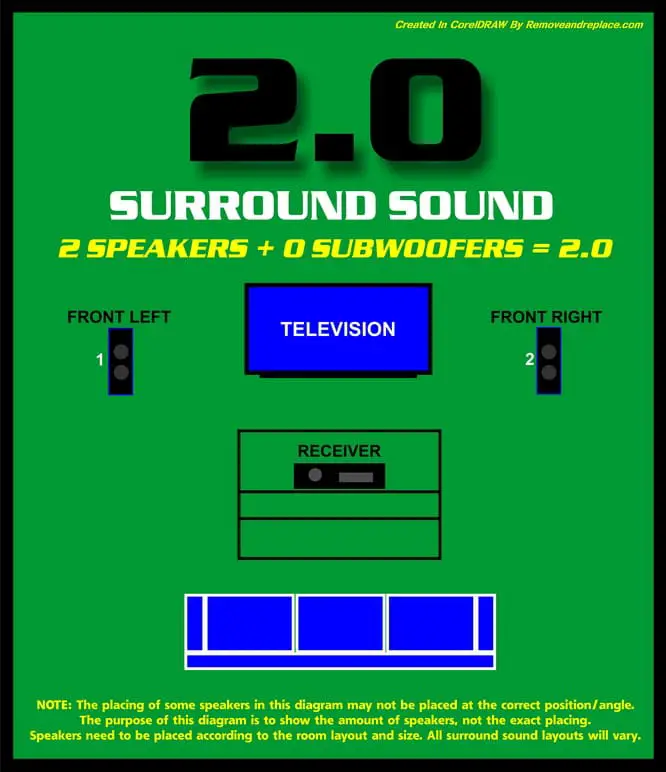 2.0: 2 main speakers – 1 left and 1 right channel speaker with no subwoofer.
2.0: 2 main speakers – 1 left and 1 right channel speaker with no subwoofer.
(The source signal has 2 main channels and no low frequency effects bass channel)
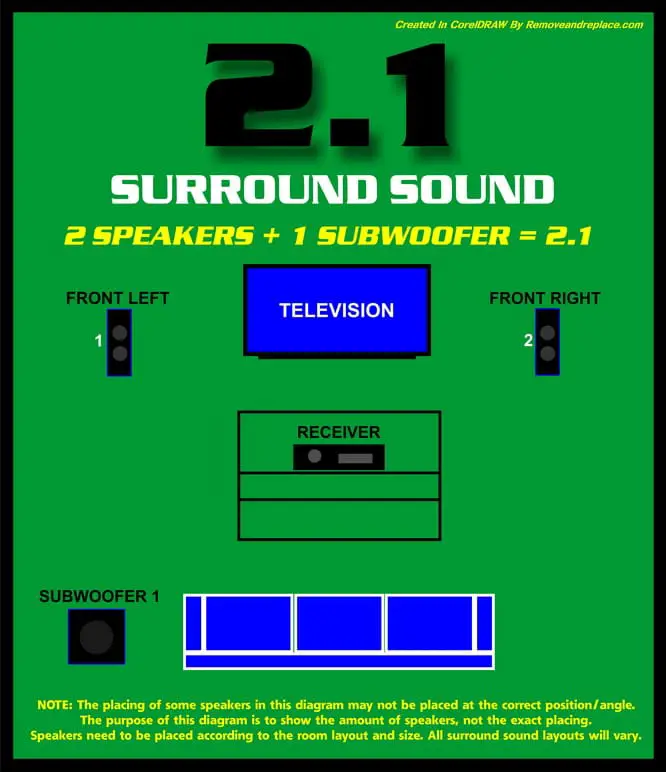 2.1: 2 main speakers – 1 left and 1 right channel speaker with 1 subwoofer.
2.1: 2 main speakers – 1 left and 1 right channel speaker with 1 subwoofer.
(The source signal has 2 main channels and 1 low frequency effects bass channel)
 3.0: 3 main speakers – 1 left and 1 right channel speaker with 1 center channel and no subwoofer.
3.0: 3 main speakers – 1 left and 1 right channel speaker with 1 center channel and no subwoofer.
(The source signal has 3 main channels and no low frequency effects bass channel)
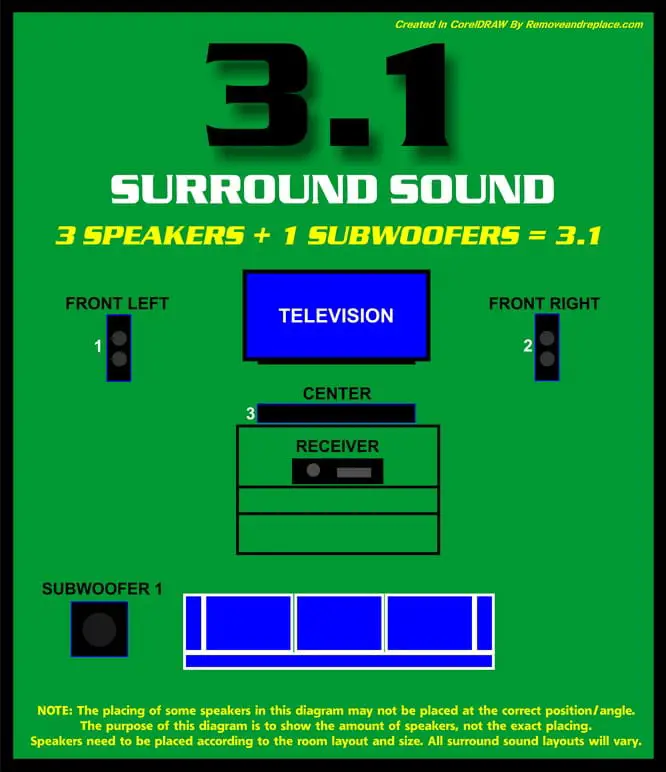 3.1: 3 main speakers – 1 left and 1 right channel speaker with 1 center channel and 1 subwoofer.
3.1: 3 main speakers – 1 left and 1 right channel speaker with 1 center channel and 1 subwoofer.
(The source signal has 3 main channels and 1 low frequency effects bass channel)
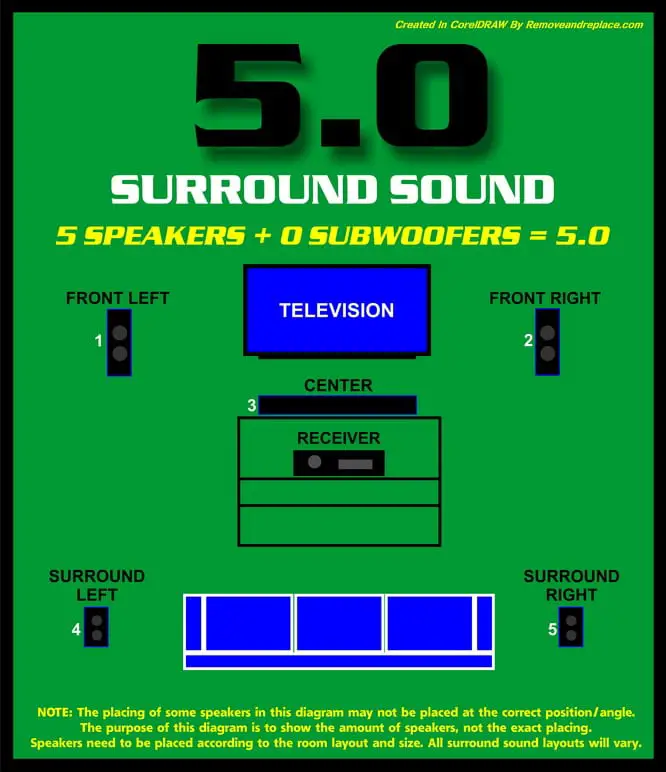 5.0: 5 main speakers – 1 Left, 1 right, 1 center, 1 surround right, 1 surround left, and no subwoofer.
5.0: 5 main speakers – 1 Left, 1 right, 1 center, 1 surround right, 1 surround left, and no subwoofer.
(The source signal has 5 main channels and no low frequency effects bass channel)
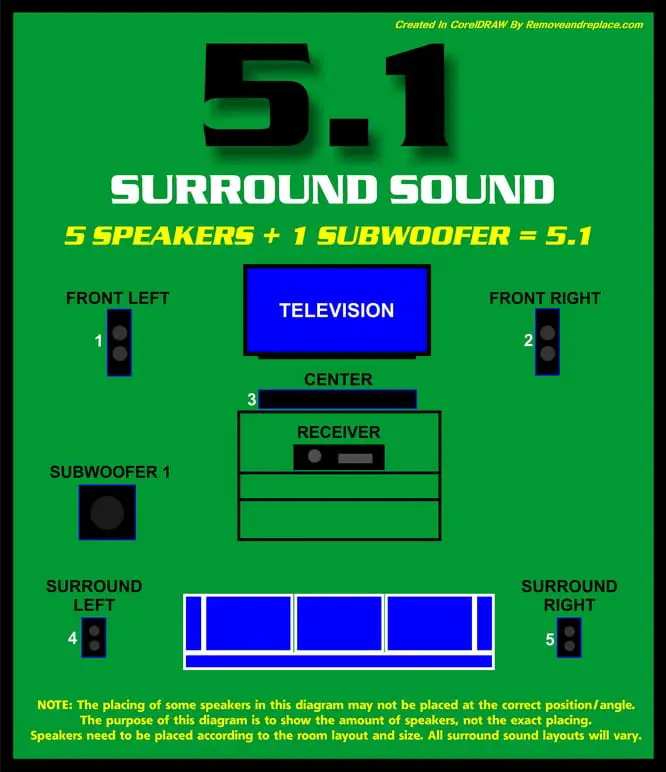 5.1: 5 main speakers – 1 Left, 1 right, 1 center, 1 surround right, 1 surround left, 1 subwoofer.
5.1: 5 main speakers – 1 Left, 1 right, 1 center, 1 surround right, 1 surround left, 1 subwoofer.
(The source signal has 5 main channels and 1 low frequency effects bass channel)
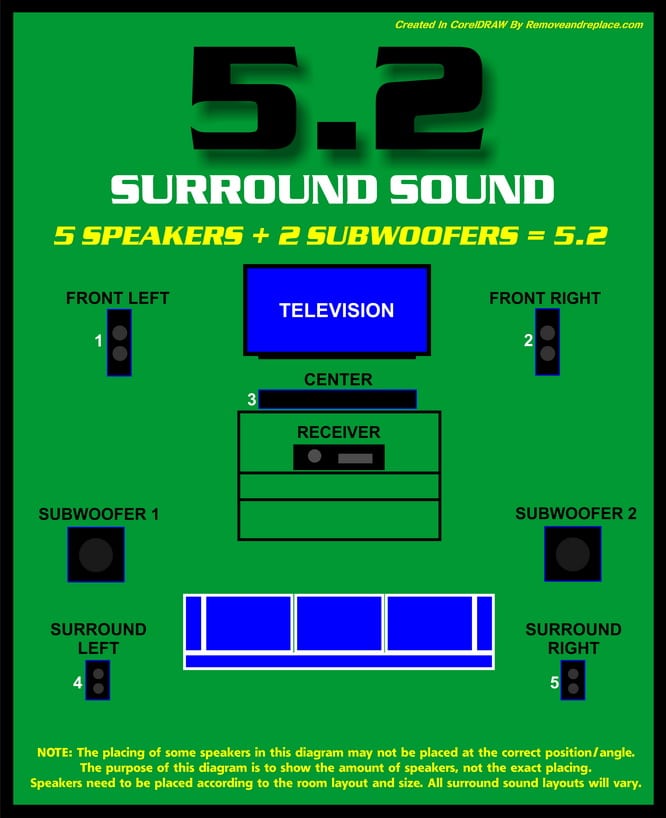 5.2: 5 main speakers – 1 Left, 1 right, 1 center, 1 surround right, 1 surround left, 2 subwoofers.
5.2: 5 main speakers – 1 Left, 1 right, 1 center, 1 surround right, 1 surround left, 2 subwoofers.
(The source signal has 5 main channels and 2 low frequency effects bass channel)
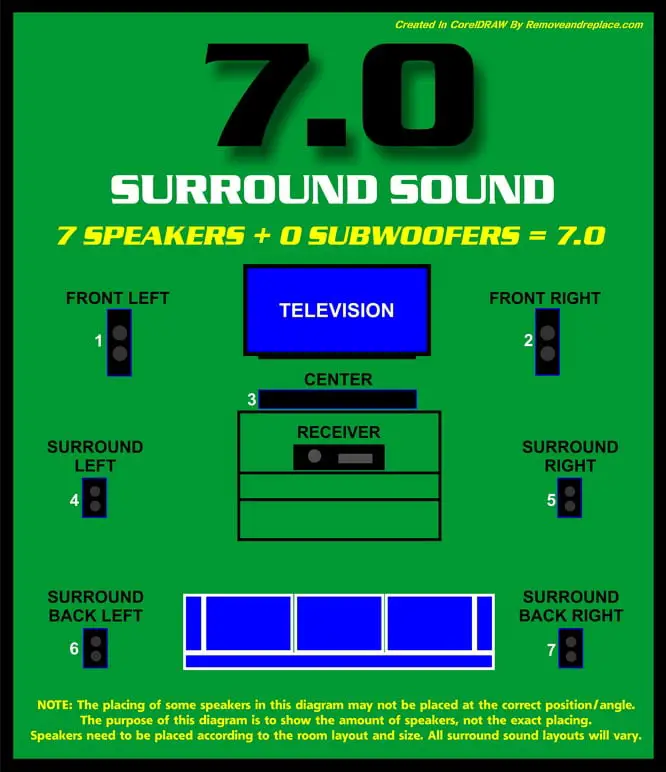 7.0: 7 main speakers – 1 Left, 1 right, 1 center, 1 surround right,
7.0: 7 main speakers – 1 Left, 1 right, 1 center, 1 surround right,
1 surround left, 1 rear right, 1 rear left, no subwoofer.
(The source signal has 7 main channels and no low frequency effect bass channel)
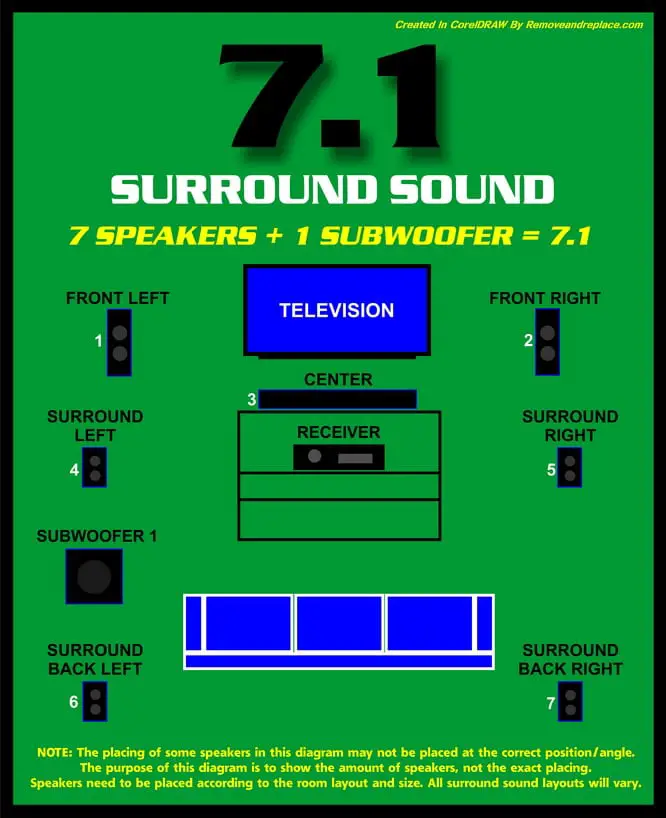 7.1: 7 main speakers – 1 Left, 1 right, 1 center, 1 surround right,
7.1: 7 main speakers – 1 Left, 1 right, 1 center, 1 surround right,
1 surround left, 1 rear right, 1 rear left, 1 subwoofer.
(The source signal has 7 main channels and 1 low frequency effect bass channel)
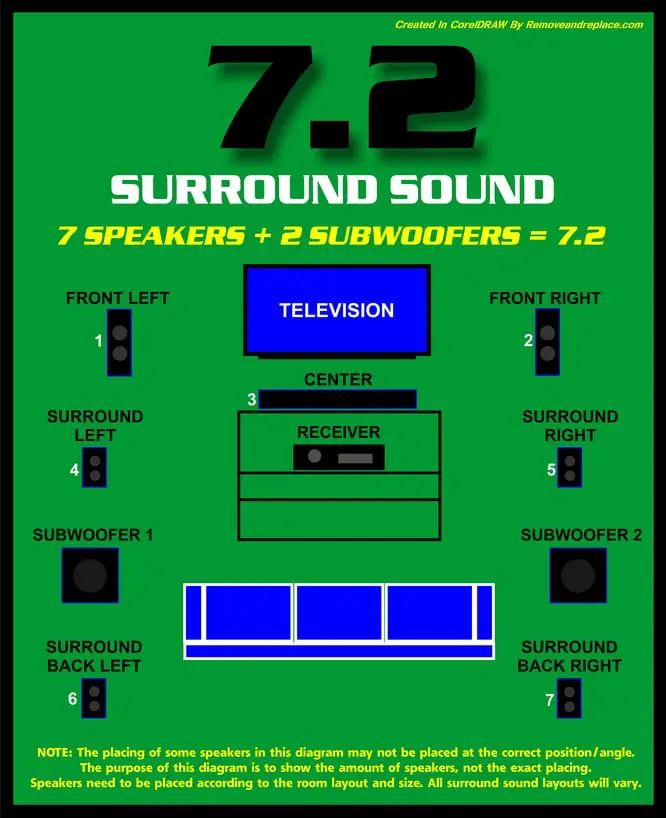 7.2: 7 main speakers – 1 Left, 1 right, 1 center, 1 surround right,
7.2: 7 main speakers – 1 Left, 1 right, 1 center, 1 surround right,
1 surround left, 1 rear right, 1 rear left, 2 subwoofers.
(The source signal has 7 main channels and 2 low frequency effect bass channels)
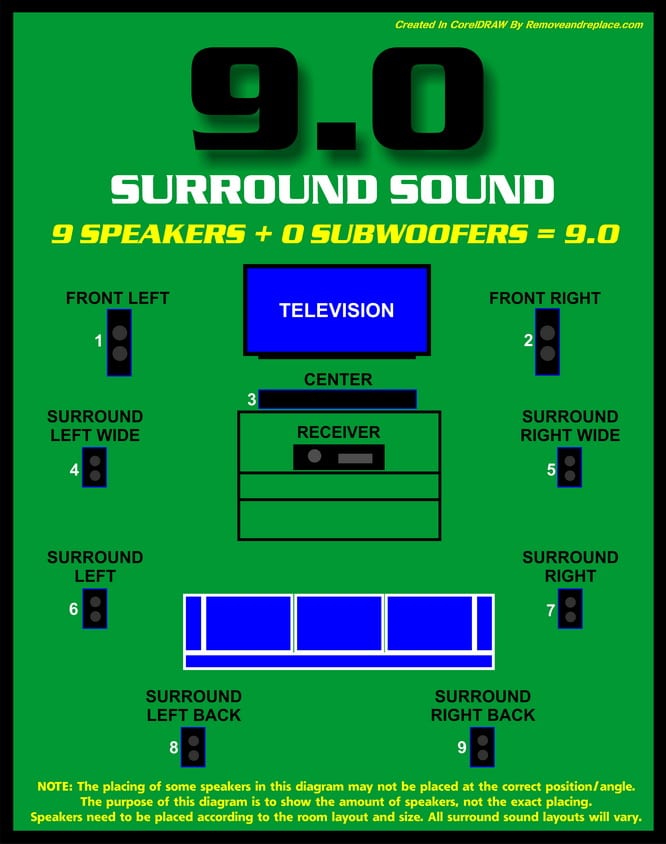 9.0: A 9.0 setup would consist of the front left and right speaker, a center,
9.0: A 9.0 setup would consist of the front left and right speaker, a center,
2 wide front speakers, 2 surrounds, 2 rear surrounds and no subwoofer.
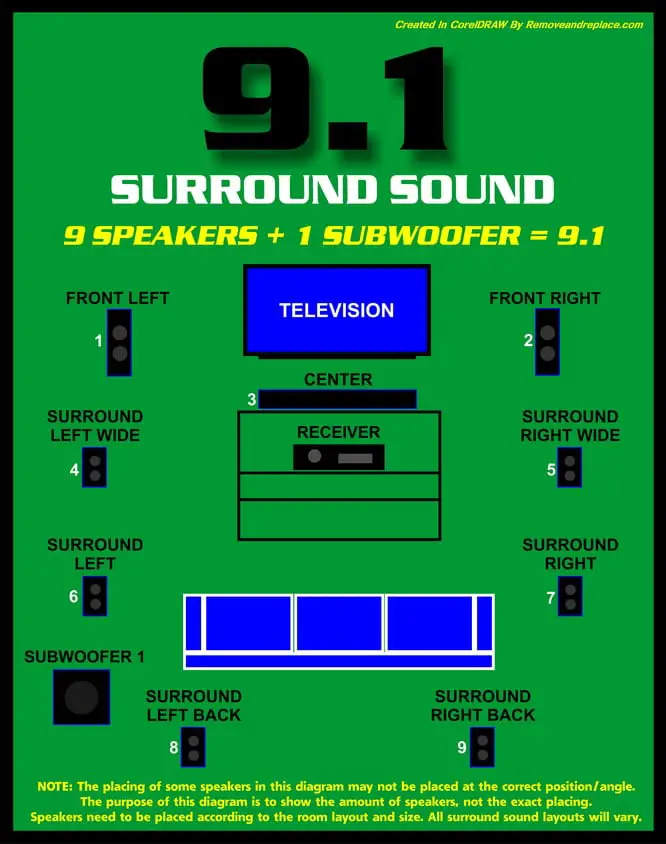 9.1: A 9.1 surround sound setup would consist of the front left and right speaker,
9.1: A 9.1 surround sound setup would consist of the front left and right speaker,
a center, 2 wide front speakers, 2 surrounds, 2 rear surrounds and 1 subwoofer.
 9.1.2: A 9.1.2 surround sound setup consists of a front left and right speakers, a center speaker,
9.1.2: A 9.1.2 surround sound setup consists of a front left and right speakers, a center speaker,
left and right wide speakers, left and right surround speakers, left and right rear surround speakers,
1 subwoofer, and 2 ceiling mounted or upward firing Dolby Atmos speakers.
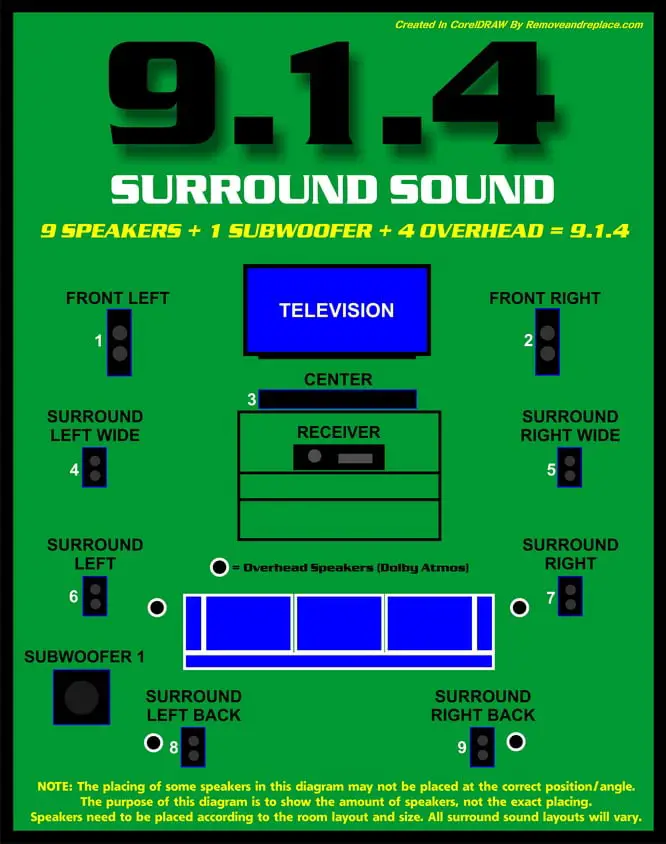 9.1.4: A 9.1.4 surround sound setup consists of a front left and right speakers, a center speaker,
9.1.4: A 9.1.4 surround sound setup consists of a front left and right speakers, a center speaker,
left and right wide speakers, left and right surround speakers, left and right rear surround speakers,
1 subwoofer, and 4 ceiling mounted or upward firing Dolby Atmos speakers.
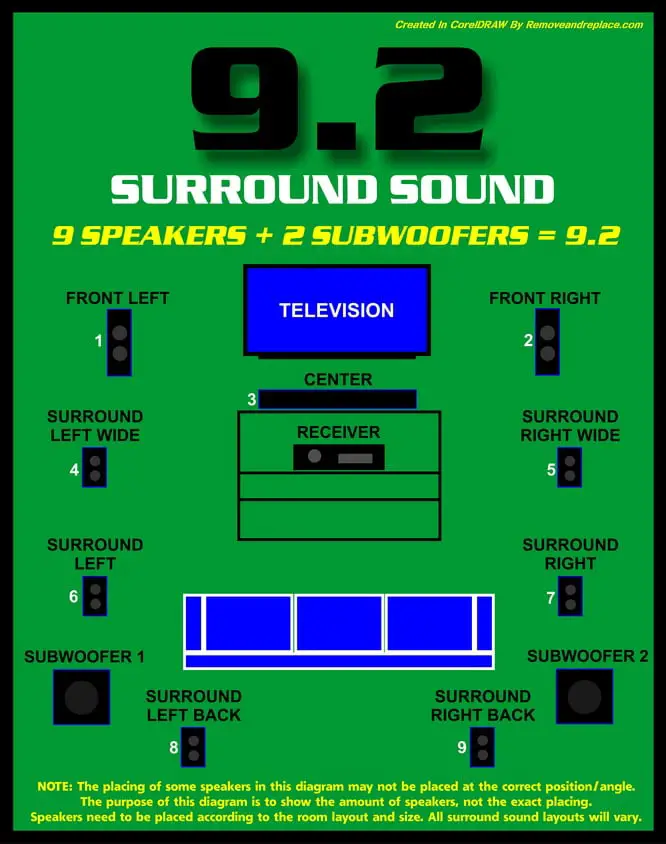 9.2: A 9.2 surround sound setup would consist of the front left and right speaker,
9.2: A 9.2 surround sound setup would consist of the front left and right speaker,
a center, 2 wide front speakers, 2 surrounds, 2 rear surrounds and 2 subwoofers.
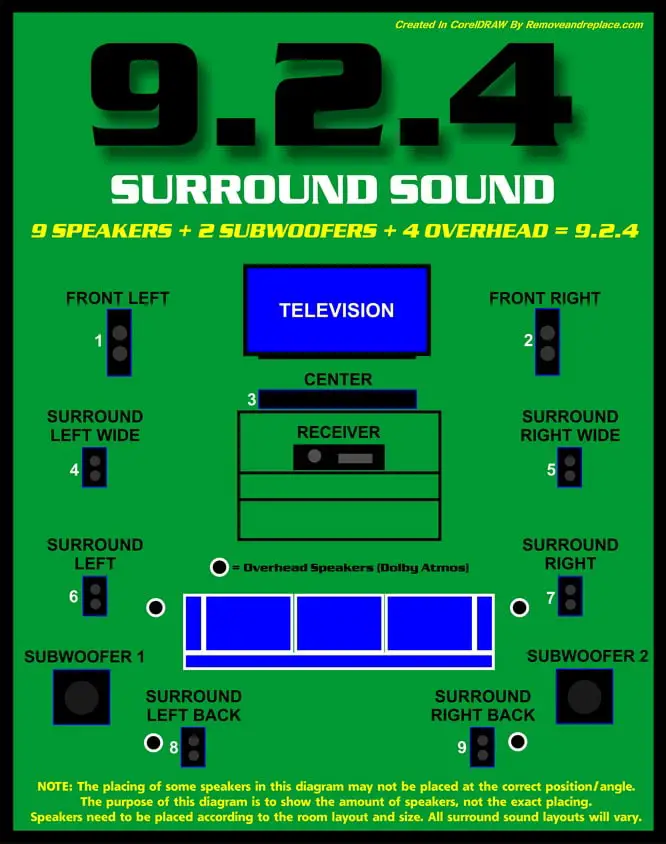 9.2.4: A 9.2.4 surround sound setup consists of a front left and right speakers, a center speaker,
9.2.4: A 9.2.4 surround sound setup consists of a front left and right speakers, a center speaker,
left and right wide speakers, left and right surround speakers, left and right rear surround speakers,
2 subwoofers, and 4 ceiling mounted or upward firing Dolby Atmos speakers.
Types Of Surround Sound Systems:
A surround sound system consists of either an audio receiver or a soundbar. A soundbar is an easier way to get different variations of surround sound. Less wiring, smaller speakers, and bluetooth is an advantage of having a soundbar over a receiver. However using a receiver with high quality speakers is the best layout for a true movie theater experience.
Some soundbars claim to be 9.2.4 capable right out of the box. Nakamichi has a Dolby Atmos enabled soundbar system with the newest firmware. For the money, some soundbar systems are perfect for big sound. They are especially practical in small living rooms or in a small apartment. The subwoofers on most soundbars are bluetooth, meaning they can be put just about anywhere in the room and no speaker wiring is required.
 Nakamichi Shockwafe Sound Bar System
Nakamichi Shockwafe Sound Bar System
Surround sound systems such as soundbars or receivers have special audio processing engines that process the audio channels encoded on a disc and recreate channels for additional surround sound. This is how the audio is produced to the extra speakers. This is where Dolby Atmos, Dolby TrueHD, Dolby Digital Plus, and Dolby Vision come into play. These special audio engines take the sound and reprocess it to produce special audio effects with a certain speaker setup.
How does a 5.1 audio system work?
5.1 is a multichannel sound technology with five channels of sound in the left, right, center, left-surround and right-surround positions. 5.1 surround sound system adds both surround and rear channel effects into 2 channels.
How does a 7.1 audio system work?
7.1 surround sound positional audio uses the standard front, center, and LFE (subwoofer) speaker configuration. A 7.1 audio system separates both the surround and rear channels into 4 different channels. The sound audio is processed to the left and right surround channels and the 2 rear surround channels.
How do Blu-Ray and 4K discs work with surround sound?
Blu-ray and 4K Ultra HD Blu-ray Discs are encoded with extra surround sound for the back or rear surround speakers. This recreates a movie theater like sound that can be experienced with the correct audio setup. The Blu-ray Disc and the HD DVD home video formats provide up to eight channels of Dolby TrueHD, lossless DTS-HD Master Audio or uncompressed LPCM audio.
Numbers In Surround Sound
1.x.x = The first number is the number of speakers or main audio channels at ear level.
x.1.x = The second number means the number of subwoofers in the sound system. Refers to the LFE (low frequency effects) channel in a surround soundtrack, which is handled by a subwoofer.
x.x.1 = The third number refers to amount of vertical or height channels that are ceiling mounted or vertically firing speakers and adds a special 3D effect. (Dolby Atmos)
Some of the benefits of having a multi channel sound system is the newer sound processing technologies such as Dolby Atmos, Dolby TrueHD, Dolby Digital Plus, and Dolby Vision can create a three-dimensional listening experience. Sounds can be precisely placed and moved in three-dimensional space.
How to setup a Dolby Atmos Surround Sound System?
Wondering how to setup a Dolby Atmos surround sound system? Here is a .pdf file that contains diagrams of standard and hybrid setups for the most common speaker configurations and are provided for both overhead speakers and Dolby Atmos enabled speakers: 5.1.2, 5.1.4, 7.1.2, 7.1.4, 9.1.2, and 9.1.4. Audio Installation – Dolby Atmos Home Theater Install Guidelines
Do you have a surround sound setup that rivals any of the above? Do you have questions concerning the numbers associated with surround sound? Do we have an incorrect explanation of a surround sound setup? Please leave your questions or comments below.




Leave a Reply